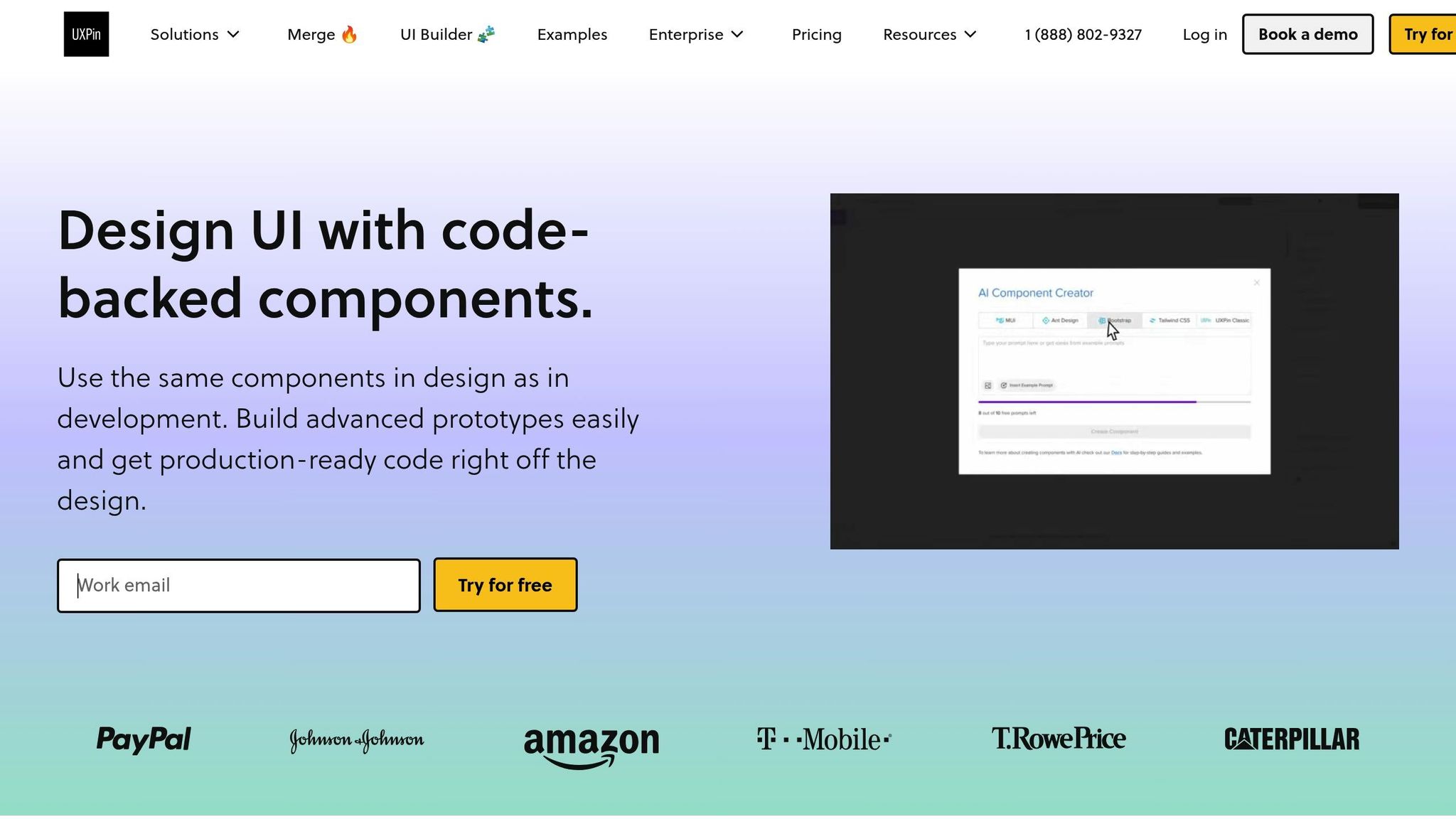Automated accessibility checks help designers create prototypes that are usable for everyone, including people with disabilities. These tools identify issues like poor color contrast, missing image descriptions, and keyboard navigation problems. Fixing these early saves time, reduces costs, and ensures compliance with standards like WCAG. Here’s what you need to know:
- Benefits: Early issue detection, lower development costs, and better user experiences for all.
- Key Features: Color contrast analyzers, keyboard navigation tests, and screen reader compatibility checks.
- Why It Matters: Avoid legal risks, meet accessibility standards, and improve usability for everyone.
Early Accessibility Testing Advantages
Save Money by Identifying Problems Early
Catching accessibility issues early in the design process saves both time and money. Fixing problems during prototyping is much faster and cheaper than addressing them after launch.
"When I used UXPin Merge, our engineering time was reduced by around 50%. Imagine how much money that saves across an enterprise-level organization with dozens of designers and hundreds of engineers." – Larry Sawyer, Lead UX Designer
For instance, tweaking a color scheme in the prototyping stage takes just a few minutes. Compare that to the time and effort needed for major code updates after the product is live. Plus, this approach often leads to better design outcomes overall.
Designs That Work Better for Everyone
Building accessibility into your prototypes results in designs that are more user-friendly for everyone – not just people with disabilities. Here’s how:
- Improved readability: High-contrast text and appropriate font sizes make content easier to read, regardless of lighting conditions.
- Easier navigation: Clear menus and consistent layouts help users find what they need quickly.
- Simpler interactions: Keyboard-friendly designs assist users with mobility challenges and even power users who prefer shortcuts.
Stay Compliant with Accessibility Standards
Testing for accessibility early helps ensure your designs align with Web Content Accessibility Guidelines (WCAG) right from the start. This approach helps organizations:
- Avoid legal trouble: Meet regulatory requirements like those outlined in the Americans with Disabilities Act (ADA).
- Lower legal risks: Reduce the chances of facing lawsuits related to accessibility issues.
Automated Checks in Practice
Common Accessibility Issues Found
Automated tools are great for spotting technical problems that impact accessibility. Some of the most frequently flagged issues include:
- Color contrast violations that don’t align with WCAG 2.1 standards
- Missing descriptive alternative text for images
- Elements that can’t be accessed using keyboard navigation
These findings highlight where manual testing can step in to address gaps and refine the process further.
Automation vs Manual Testing
Automated tools are fast and efficient, but they work best when paired with manual testing. Here’s a quick comparison:
| Testing Aspect | Automated Checks | Manual Testing |
|---|---|---|
| Speed | Scans hundreds of elements in seconds | May take days or weeks |
| Consistency | Delivers uniform results | Results can vary between testers |
| Technical Issues | Excels at spotting code-level problems | Limited in detecting technical issues |
| Context Understanding | Can’t judge meaningful alt text | Evaluates quality and context better |
| Cost Efficiency | Great for repeated testing | Requires more resources |
"What used to take days to gather feedback now takes hours. Add in the time we’ve saved from not emailing back-and-forth and manually redlining, and we’ve probably shaved months off timelines."
– Mark Figueiredo, Sr. UX Team Lead at T.RowePrice
Live Testing Features
Live testing takes accessibility checks a step further by providing real-time feedback during the design process. For instance, UXPin’s live testing tools can instantly evaluate:
- Color contrast ratios to ensure WCAG compliance
- Keyboard navigation flow for usability
- Screen reader compatibility to confirm accessibility
These features let teams catch and fix issues early, saving time and avoiding major revisions later. By addressing accessibility concerns directly within the workflow, designers can ensure their prototypes meet standards right from the start.
sbb-itb-f6354c6
4 Steps to Add Accessibility Checks
1. Select Testing Tools
UXPin offers built-in tools to help ensure accessibility, including:
- Color contrast analyzer to meet WCAG 2.1 guidelines
- Keyboard navigation tests to verify full accessibility
- Screen reader compatibility checks to ensure proper HTML semantics
- Component-level testing for code-backed elements
2. Establish a Testing Process
Incorporate automated accessibility checks into your workflow by:
- Setting up testing parameters tailored to your project
- Enabling real-time feedback and running automated checks with every update
- Creating a detailed checklist of accessibility requirements
These steps help streamline testing and catch issues early in the design process.
3. Address Issues
Resolve identified problems step by step:
- Review the test results from automated tools
- Focus on fixing high-priority issues first
- Use code-backed components to maintain consistency across designs
- Document all changes for team collaboration and future reference
UXPin’s code-backed prototyping ensures that accessibility standards are consistently applied throughout your design system. After resolving issues, verify your fixes and make adjustments as needed.
4. Test and Update Regularly
Schedule regular tests to maintain compliance over time:
- Run automated checks on all prototypes
- Confirm fixes using UXPin’s built-in tools
- Update your component libraries based on test results
- Stay informed about accessibility standards and adjust your designs accordingly
| Testing Phase | Key Actions | Benefits |
|---|---|---|
| Initial Setup | Configure automated checks | Identify issues early |
| Regular Testing | Perform scheduled scans | Maintain compliance |
| Issue Resolution | Fix problems with code-backed components | Ensure consistent standards |
| Validation | Verify fixes using testing tools | Confirm improvements |
Automated Accessibility Testing by Anna Maier
Conclusion
Here’s a quick recap of how automated accessibility checks and UXPin’s tools can improve prototype quality.
Key Takeaways
Integrating automated checks early in the process offers clear advantages:
- Quicker issue identification and fixes
- Consistent compliance with WCAG standards
- Reduced development costs
- Designs that are more inclusive for all users
These points highlight the importance of incorporating UXPin’s accessibility tools into your prototyping workflow.
UXPin‘s Accessibility Tools

"I think UXPin is an underrated powerhouse of design and prototyping that allows complex applications to design low, medium, and high-fidelity designs to communicate complex interactions all in one place quickly and effectively." – Benjamin Michel, UX Designer at Bottomline Technologies
UXPin’s testing tools make accessibility easier by offering features that improve workflow efficiency and design consistency. Here’s what the platform provides:
| Feature | Purpose |
|---|---|
| Color Contrast Analyzer | Checks visual elements for WCAG 2.1 compliance |
| Keyboard Navigation Testing | Confirms full keyboard accessibility |
| Screen Reader Compatibility | Verifies proper HTML semantics for assistive technologies |
| Component-Level Testing | Ensures accessibility is consistent across your design systems |
These features help teams create accessible prototypes without sacrificing quality or efficiency during development.

